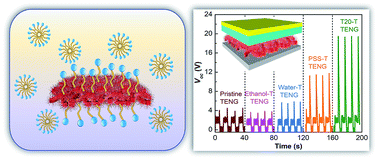Mechanical energy harvester based on cashmere fibers†
Abstract
Fabrication of a flexible, lightweight and cost-effective mechanical energy harvester is a promising approach for next-generation wearable electronics. Herein, a triboelectric mechanical energy harvester based on cashmere fibers is developed for the first time using a facile fabrication process with polytetrafluoroethylene as the triboelectric counterpart. The surface properties of cashmere play a significant role in output performance. Remarkable power output can be achieved when subjected to Tween 20 treatment with an open-circuit voltage of 19.5 V, which is 4.5-fold higher than that of a pristine fiber based harvester. As a H-bond donor, the lowered ionization potential of cashmere significantly increases its tendency to lose electrons during contact electrification. The treated cashmere based harvester can achieve an output power density of 41.7 mW m−2 at a load resistance of 14.1 MΩ. Additionally, the device displays good stability over a wide range of relative humidity. This study demonstrates a new approach for surface modification via mild solvent treatment. Successful demonstration of a cashmere based harvester as a power source for light-emitting diodes shows potential application in self-powered wearable electronics.



 Please wait while we load your content...
Please wait while we load your content...